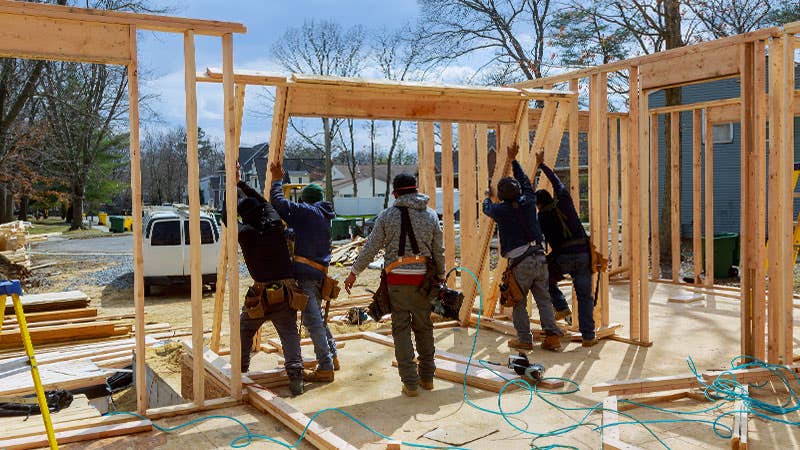How much does it cost to build a house?

How much does it cost to build a house?
The average cost to build a single-family, 2,600-square-foot home is $296,652, according to a National Association of Home Builders (NAHB) survey.
That price, however, varies widely depending on the region of the country where you’re building in and can be as high as $750,000 or as low as $15,000 according to Rocket Mortgage.
Cost of new construction per square foot by region
In the Northeast: $135 per square foot
In the West: $151 per square foot
In the Midwest: $116 per square foot
In the South: $92 per square foot
However, these figures only take into consideration the cost of construction. They do not include the cost of the lot, which averages nearly $90,000, as well as additional expenses.
Home building costs
You’ll need to take into account a number of factors in order to estimate the true cost of building your new home. Here are some of the costs to include in the construction budget.
Construction phaseAverage costPre-construction$18,000Foundation and framing$87,000Exterior$42,000Home systems (Electrical, HVAC, plumbing)$40,000-$45,000Interior$75,000Outdoor (Driveway, landscaping)$20,000Labor$40 to $80 per square footLand$90,000Source: National Association of Home Builders
Pre-construction costs
You’ll need to secure the appropriate permits and pay fees to your city or municipality before the work on your home can begin. You’ll also need to hire architects and engineers to make plans for your home. These costs all vary by location, but the average total is around $18,000.
Foundation and framing
The structure of your new home is a major part of the cost and can total a quarter of the total construction price. Overall, you’re looking at around $87,000 for foundation and framing.
Exterior completion
You’ll have to complete the exterior with a roof, siding, windows and doors once the frame of your house is in place. The average cost is about $42,000.
Electrical, plumbing and HVAC
The infrastructure that heats your house and provides water and electricity is an essential part of your home. Most homeowners spend in the neighborhood of $40,000-$45,000 to have all of these components installed.
Interior completion
From insulation and drywall to cabinets and flooring, finishing the interior of your home is one of the most expensive parts of the project. The nationwide average cost is $75,000 to complete work on the interior of a home, but this can go up significantly depending on your purchase decisions.
Outdoor structures
Most homes have a driveway and many also include a deck or patio and some form of landscaping. These features might seem trivial, but they add up quickly. Homeowners spend an average of $20,000 in this category.
Labor
Labor is one of the most important costs involved in home construction and also one of the most difficult to measure. The final price tag will vary significantly based on each new home’s plans and the amount of work involved. HomeAdvisor says the cost of new home construction is generally between $100 to $200 per square foot and labor often makes up about 40 percent of that cost. However, labor prices can vary from anywhere between 30 to 60 percent of overall project cost.
You can expect to pay for a long list of specialized experts to help complete your home project. A 2020 NAHB survey found that 69 percent of homebuilders use between 11 to 30 subcontractors to build the average single-family home, with the average being about 24 different subcontractors per home.
While a variety of trades contribute to the construction of a home, some of the most common subcontractors hired by builders are those specializing in HVAC, electrical wiring and plumbing, carpeting, security systems, masonry and drywall. Roofers, flooring experts, painters and framers are also widely used.
Like many other costs associated with home building, the cost of labor increased during the pandemic thanks to greater numbers of homeowners engaging in remodeling projects.
“Labor costs haven’t risen as much as input costs like construction lumber, but they are higher,” says Mischa Fisher, chief economist for Angi. “You may also face long wait times for high-quality tradespeople due to high demand.”
Land
Of course, before embarking on new home construction, you will need a place for it to be located. The land costs associated with new home construction typically include the purchase price for the property and also land preparation such as tree removal or land leveling.
Like many other factors associated with the construction of a new home, the cost of land can vary significantly from place to place. According to the NAHB, the average cost of a finished lot is about $90,000.
Is it cheaper to buy or build a home?
Building a new home tends to cost more than buying a pre-owned property, but how much more depends on many factors, such as the size of the new home, the project scope and the materials the homeowner chooses.
The cost of home building materials such as lumber spiked during the pandemic. The home remodeling site Fixr reported that lumber costs increased 430 percent between 2020 and 2021, reaching a record-breaking high of more than $1,300 for 1,000 board feet. About 88 percent of homes in the US are constructed using lumber framing and lumber is also used in many other parts of home construction.
“While it depends on the location and size of the home, buying an existing home and remodeling is probably cheaper than building in many areas,” says Fisher. “In many markets, lumber still costs 200 to 400 percent more than it did at the start of the pandemic. Even in the most expensive metro areas, average existing home prices aren’t likely to have risen anywhere near that level.”
Just how much you will save by purchasing an existing home rather than building one depends on the type of property you buy and the condition it is in.
“If you’re willing to live in a home that doesn’t necessarily have this year’s remodeling upgrades, there’s a lot of money to save by buying a house rather than building one,” says Thomas Jepsen, founder of Passion Plans, a website that helps consumers build their dream homes. “The typical rule still applies — you’re saving money upfront by buying over building.”
It’s important to think about your priorities, says David Logan, senior economist at the NAHB. New homes tend to be bigger and more customized, but are also often farther from city centers and public transportation because land is cheaper and easier to acquire on the outskirts of town.
Home building financing options
If you’ve determined that the price of construction is worth it, your next step is to explore your home building financing options. There are several options available to potential homeowners, and many offer competitive interest rates and attractive incentives.
Home construction loan
By far the most common form of financing the cost to build a house, home construction loans are designed exactly for this purpose. There are two main types:
Construction-to-permanent loans
Construction-only loans
Construction-to-permanent loans are a single loan that covers the cost of the land and construction, eventually functioning in the same way as a mortgage. Construction-only loans, also known as standalone construction loans, only finance the construction of your new home and require you to take out two separate loans, which can lead to higher fees and interest rates.
However, a construction-only loan might make more sense if you currently own a home and plan to sell it and use the proceeds to pay off the loan on your newly constructed home.
Personal loan
You probably won’t come close to financing the entire cost of building a house with a personal loan — the loan amount will be capped for most people at much less than the cost of a house — but you may use this method to pay for specific projects.
For example, if you’ve already secured a certain amount of financing for the construction of your home but need additional financing for landscaping, a personal loan could do the trick. Just keep an eye on your finances and make sure you’re not overcommitting when it comes time to repay multiple loans.
Home equity loan
If you already own a home and want to build another one, you may want to consider using a home equity loan on your first house to finance all or part of the second. The amount you can borrow will depend on how much equity you have in your current home. If you own it outright, you might easily be able to finance the majority of your new home.
Once construction is complete and you move into your new home, you can use the money from the sale of the first house to pay off the home equity loan.
Home equity line of credit (HELOC)
A home equity line of credit (HELOC) is another good option for financing the cost of building a house, provided you have a significant amount of equity. Like a home equity loan, you’ll borrow against the equity in your current house to procure financing to build a new one. The difference is that a HELOC acts more like a credit card than a lump-sum loan, and you’ll be able to borrow from the line of credit as needed up to the amount that you’re approved for.
You’ll also have more flexibility and can choose how much you actually borrow from a HELOC, and you can pay it back and borrow again as needed. This is highly advantageous when constructing a new home, since costs often fluctuate and additional unforeseen expenses can arise at any moment.
Tips to save on building a house
The best way to save on building a house is to get multiple quotes for every step of the process. Talk to several real estate agents, architects, builders and designers and ask each for a written estimate. If one quote is significantly cheaper than the rest, find out why before signing on the dotted line. You don’t necessarily want to pick the least expensive option; it could leave you with a poorly built house that requires frequent emergency repairs or costly add-ons that weren’t included in the initial quote.
You can also save money by doing some of the work yourself. For example, instead of hiring an interior designer, think about choosing the interior finishes yourself. Just be prepared for a significant time investment if you decide to take this route, as you’ll be responsible for choosing everything from flooring to paint to countertops.
Next steps: How to build a home
After developing a rough estimate of the cost to build your house, you can go to a financial institution and apply to be preapproved for a certain amount.
Once you’re approved, it’s time to start working with a real estate agent to find a lot, and also to contact an architect and builder to make plans. A good team of professionals will be able to work within your budget so that the cost of building a house won’t exceed what you can afford.
